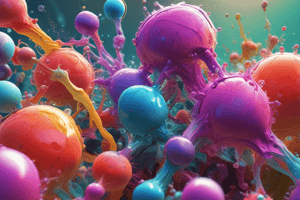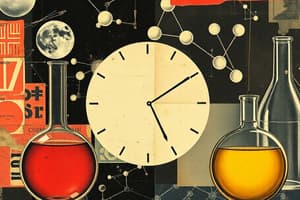Podcast
Questions and Answers
What is the chemical formula for the compound formed from Fe3+ and the oxide ion?
What is the chemical formula for the compound formed from Fe3+ and the oxide ion?
- Fe2O3 (correct)
- FeO3
- Fe3O2
- Fe3O
What is the correct name for the compound TiO2?
What is the correct name for the compound TiO2?
- titanium oxide
- titanium(II) oxide
- titanium(IV) oxide (correct)
- titanium dioxide
What is the name of the compound P4O10?
What is the name of the compound P4O10?
- phosphorus(IV) oxide
- tetraphosphorus decoxide (correct)
- diphosphorus pentoxide
- phosphorus oxide
How many atoms are present in 50 moles of sulfur?
How many atoms are present in 50 moles of sulfur?
Determine the mass in grams of 2.70 × 10^23 atoms of potassium.
Determine the mass in grams of 2.70 × 10^23 atoms of potassium.
Which statement must be true regarding the substances in the flask?
Which statement must be true regarding the substances in the flask?
What type of mixture involves two or more substances in variable proportions with constant composition throughout?
What type of mixture involves two or more substances in variable proportions with constant composition throughout?
Which of the following describes a chemical change?
Which of the following describes a chemical change?
Which order of quantities is correct from smallest to largest: 0.02 ng, 2 μg, 2 × 10^4 pg?
Which order of quantities is correct from smallest to largest: 0.02 ng, 2 μg, 2 × 10^4 pg?
What is the most probable identity of a metal with a volume of 118 cm³ and a mass of 929 g?
What is the most probable identity of a metal with a volume of 118 cm³ and a mass of 929 g?
How many significant zeroes are in the number 0.030700?
How many significant zeroes are in the number 0.030700?
What is the correct answer when calculating 50.02 cm – 4.444 cm + 2.5 cm with proper precision?
What is the correct answer when calculating 50.02 cm – 4.444 cm + 2.5 cm with proper precision?
Which of the following best describes the scientific notation for (3.0 × 10^3)²?
Which of the following best describes the scientific notation for (3.0 × 10^3)²?
What is the result of the calculation $6.78 \times 5.903 \times (5.489 - 5.01)$?
What is the result of the calculation $6.78 \times 5.903 \times (5.489 - 5.01)$?
What describes the measurements of the copper pellets given their true mass is 10.5 g?
What describes the measurements of the copper pellets given their true mass is 10.5 g?
How many cubic yards of concrete are needed to create a patio of dimensions 12 ft by 12 ft by 0.50 ft?
How many cubic yards of concrete are needed to create a patio of dimensions 12 ft by 12 ft by 0.50 ft?
If the walls of a room are 102 square meters and a gallon of paint covers 23.0 square yards, how many gallons are needed?
If the walls of a room are 102 square meters and a gallon of paint covers 23.0 square yards, how many gallons are needed?
Which hypothesis in Dalton's atomic theory was proven incorrect by later experiments?
Which hypothesis in Dalton's atomic theory was proven incorrect by later experiments?
What key observation in the cathode ray experiments indicated that electrons have a negative charge?
What key observation in the cathode ray experiments indicated that electrons have a negative charge?
In Rutherford’s gold foil experiment, what conclusion was drawn about the nucleus?
In Rutherford’s gold foil experiment, what conclusion was drawn about the nucleus?
How many protons, neutrons, and electrons are in a neutral atom of the isotope $^{13}C$?
How many protons, neutrons, and electrons are in a neutral atom of the isotope $^{13}C$?
What is the calculated atomic mass of element 'Ma' based on provided isotopes?
What is the calculated atomic mass of element 'Ma' based on provided isotopes?
What is the charge on an atom containing 18 protons, 19 neutrons, and 20 electrons?
What is the charge on an atom containing 18 protons, 19 neutrons, and 20 electrons?
Which of the following combinations indicates a molecular compound?
Which of the following combinations indicates a molecular compound?
What is the most likely charge for tellurium (Te) as derived from the periodic table?
What is the most likely charge for tellurium (Te) as derived from the periodic table?
What element has atomic number 16?
What element has atomic number 16?
Which type of element is represented by the symbol Cl2?
Which type of element is represented by the symbol Cl2?
Which statement about neutrons is correct?
Which statement about neutrons is correct?
Flashcards
What is a compound?
What is a compound?
A substance cannot be broken down into simpler substances by physical means, but can be broken down into simpler substances by chemical means.
What is a mixture?
What is a mixture?
A mixture contains two or more substances that are not chemically bonded and can be separated by physical means.
What is a homogeneous mixture?
What is a homogeneous mixture?
A homogeneous mixture has a uniform composition throughout. Every part of the mixture has the same properties.
What is a heterogeneous mixture?
What is a heterogeneous mixture?
Signup and view all the flashcards
What is a chemical change?
What is a chemical change?
Signup and view all the flashcards
What is a physical change?
What is a physical change?
Signup and view all the flashcards
How do you calculate density?
How do you calculate density?
Signup and view all the flashcards
What are significant figures?
What are significant figures?
Signup and view all the flashcards
Precise, but not accurate
Precise, but not accurate
Signup and view all the flashcards
Precise and accurate
Precise and accurate
Signup and view all the flashcards
Neither precise nor accurate
Neither precise nor accurate
Signup and view all the flashcards
Precision
Precision
Signup and view all the flashcards
Accuracy
Accuracy
Signup and view all the flashcards
Dimensional Analysis
Dimensional Analysis
Signup and view all the flashcards
Dalton's atomic theory.
Dalton's atomic theory.
Signup and view all the flashcards
Dalton's Atomic Theory – Hypothesis 1
Dalton's Atomic Theory – Hypothesis 1
Signup and view all the flashcards
Dalton's Atomic Theory – Hypothesis 2 (incorrect)
Dalton's Atomic Theory – Hypothesis 2 (incorrect)
Signup and view all the flashcards
Dalton's Atomic Theory – Hypothesis 3
Dalton's Atomic Theory – Hypothesis 3
Signup and view all the flashcards
Dalton's Atomic Theory – Hypothesis 4
Dalton's Atomic Theory – Hypothesis 4
Signup and view all the flashcards
Atomic number
Atomic number
Signup and view all the flashcards
Mass number
Mass number
Signup and view all the flashcards
Isotopes
Isotopes
Signup and view all the flashcards
Nucleus
Nucleus
Signup and view all the flashcards
Iron(III) Oxide Formula
Iron(III) Oxide Formula
Signup and view all the flashcards
Name of TiO2
Name of TiO2
Signup and view all the flashcards
Name of P4O10
Name of P4O10
Signup and view all the flashcards
Empirical Formula
Empirical Formula
Signup and view all the flashcards
Mole to Atom Conversion
Mole to Atom Conversion
Signup and view all the flashcards
Study Notes
Matter Classification and Separation
- Substance: A pure form of matter with a fixed composition.
- Element: A substance that cannot be broken down into simpler substances by chemical means (e.g., gold, oxygen).
- Compound: A substance composed of two or more elements chemically combined in a fixed ratio (e.g., water, carbon dioxide).
- Mixture: Two or more substances physically combined in variable proportions; homogeneous mixtures have uniform composition throughout, while heterogeneous mixtures do not.
Chemical vs. Physical Changes
- Chemical change: A change in which one or more substances are transformed into new substances with different properties (e.g., burning wood, rusting iron).
- Physical change: A change that alters the form or appearance of a substance but does not change its chemical composition (e.g., melting ice, dissolving sugar).
Significant Figures and Calculations
- Significant figures: Digits in a measured value that are known with certainty plus one uncertain digit. Follow rules for addition/subtraction and multiplication/division when rounding results to the correct number of significant figures.
- Precision: How close repeated measurements are to each other.
- Accuracy: How close a measurement is to the true value.
Density Calculations
- Density: Mass per unit volume (g/cm³ or g/mL); used to identify substances.
Scientific Notation
- Numbers in scientific notation are written as a coefficient multiplied by 10 raised to a power. Follow rules for calculations with scientific notation.
Metric Conversions and Dimensional Analysis
- Use dimensional analysis to convert between units, ensuring units cancel appropriately. Conversion factors are used to make conversions from one unit to another.
Atomic Structure and Isotopes
- Atomic number: The number of protons in an atom's nucleus. It defines the element.
- Isotopes: Atoms of the same element with different numbers of neutrons, hence different mass numbers.
- Atomic mass: The weighted average mass of all the naturally occurring isotopes of an element.
- Protons, neutrons, and electrons: Protons and neutrons are in the atom's nucleus; the number of electrons in a neutral atom equals the number of protons. Isotopic symbols display mass number/atomic number and element symbol.
Ions and Chemical Formulas
- Ions: Charged atoms (cations are positive, anions are negative).
- Chemical formulas: Represent the composition of compounds showing the ratio of elements.
- Naming chemical compounds: Use systematic rules for naming both ionic and molecular compounds
- Empirical vs Molecular formulas: Empirical formulas give the simplest whole-number ratio of elements in a compound, while molecular formulas show the actual number of each type of atom in a molecule.
Moles and Atoms
- Mole (mol): A unit representing 6.02 × 10²³ particles (atoms, molecules, or ions).
- Molar mass: The mass in grams of one mole of a substance.
- Use dimensional analysis to convert between moles and atoms or grams and moles.
Classifying Elements
- Elements can be classified as atomic (monatomic elements; e.g. Argon) or molecular (diatomic elements; e.g. Chlorine)
Studying That Suits You
Use AI to generate personalized quizzes and flashcards to suit your learning preferences.





